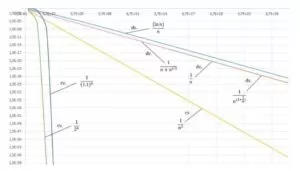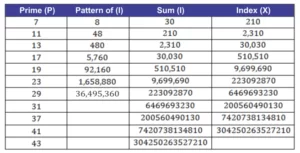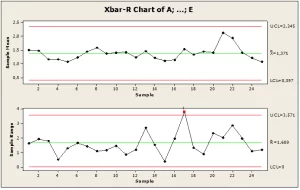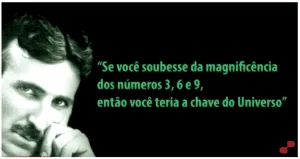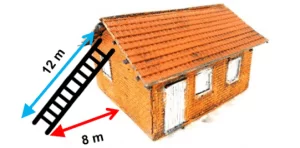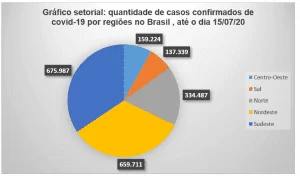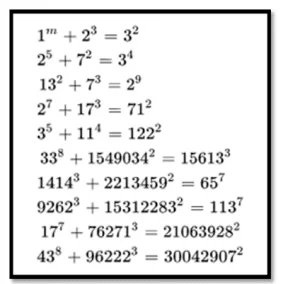FREIRE, Amanda Freitas [1], RODRIGUES, Fabiana Soares [2], AQUINO, Maria Rosane Souza [3], SOARES, Maria Vanessa [4], GOIS, David Denis Pires de [5], VIANA, José Damião [6]
FREIRE, Amanda Freitas; et.al. The use of the Geoboard in teaching Geometry: calculating area and perimeter. Multidisciplinary Core scientific journal of knowledge. 03 year, Ed. 06, vol. 03, pp. 119-135, June 2018. ISSN:2448-0959
Summary
This research brings as its central theme the teaching of calculating area and perimeter of figures in the plane geometry, using as a resource the Geoboard. Defends itself, in this article, the idea that through the use of manipulable materials is possible to facilitate the teaching/learning content, similarly develop the reasoning and the interest of students in solving problems. In this article will be presented with a field of qualitative character, which occurred in the final series of elementary school, held at the eighth grade "C" State school Journalist Edson Régis, in São Cristóvão neighbourhood in the city of Arcoverde-PE, a workshop held through the Institutional Program of Initiation to Teaching (PIBID). During the workshop it was noted an effective participation in class and also an improvement in student performance.
Keywords: teaching mathematics, plane geometry, Geoboard.
Introduction
Today, we live in a kind of this increasingly focused on technological advances, and the meeting is required for the various human actions from simple to complex things. The mathematical knowledge is of utmost importance for the individual relates to society and the environment in which he lives. This knowledge nowadays do not present in the daily life of many students, by difficulties in establishing relationships than learned with day to day situations. The BNCC (National Common Curriculum Base) reports on this connection that the students have to establish the knowledge acquired with daily events, and describes the following:
It is important to highlight that this association between the physical world that surrounds us and the unknown world of mathematics can be related to a double. For example, while a parallelepiped rectangle acts as an abstract model for the physical object shoebox, to the abstract model of spatial geometric figure sphere, we can associate the object of physical world football (BRAZIL, 2015) .
The objective of this research is to highlight the importance of the use of teaching resources in Mathematics Learning and teaching of plane geometry, specifically the calculation of area and perimeter. So be in the physical world or immaterial mathematics is present in everything around us, so it is important to your knowledge. In the classroom the complexity in associate mathematics with the day to day, it becomes more present, once the issues and questions presented are not represented in a way in which the student can touch and pose with something physical. These issues are presented in a way only imaginary. So when is there any feature that allows the teacher can expose in your physical form to the impasse and the questions raised, the teaching becomes more attractive and easy to understand for the student.
Leaving these difficulties presented arise some questions: how to make math education more attractive to students? The use of the Geoboard as teaching tool would facilitate the learning of students? How we as educators can make the teaching/learning more versatile? It is crucial that teachers make use of the knowledge that the student already possesses and leaving that point can be made that known connections with math. Nothing is more useful to use the instructions learned in problems that arise on the society. With this we developed this research through the Institutional Program of Initiation to Teaching (P[7]IBID) of the municipality of Superior Education of Arcoverde (EFSA), in order to introduce the student to a Math crafted with teaching resources. We suggest the Geoboard as a tool for teaching/learning of calculating area and perimeter of plane figures, for students of the final series of elementary school II, specifically the 8th year Journalist Edson Régis located in Arcoverde-PE and. Since with this feature we can explore basic concepts of plane geometry or non-Euclidean geometry such as: point, line and plane.
The first geometrical ideas originated with the human capacity to seek alternatives to resolve practical problems:
Seeking the origin of the development of geometry in the early days, with the primitive man, we can imagine that the knowledge space configurations, shapes and sizes have originated, possibly with the human capacity to observe and reflect on the displacements, with the construction of strategies for hunting and food crop, with the creation of tools and utensils, in order to satisfy their basic needs. To secure housing, with the Division of labor, other needs were emerging and the production of geometric knowledge widening. The need for building, delimit the land led to the notion of figures and curves and positions as vertical, perpendicular, parallel (GH, 2008, p. 7).
Methodology
It is a research with qualitative approach, which was used a technique of field research. As an instrument of data collection were used questionnaires, interviews and observation.
In search of answers to the questions presented in the introduction, we carry out different activities such as interviews with teachers and students, and a workshop using the Geoboard. At first, was interviewed the Regent's professor of eighth grade "C", and soon after the series that precedes, a questionnaire was drawn up containing five questions: do you know the Geoboard? You use some type of resource for teaching geometry? What are the difficulties encountered during these classes? During class, you've presented the main flat geometric figures? How do you teach the calculation of areas and perimeters.
With regard to students, a questionnaire was applied to thirty students with five questions, some of them are: do you know the Geoboard? Geometry class the teacher used some sort of usable material? You know what is perimeter? And area? You know how to calculate the perimeter and the area of these figures?
To analyze the answers, one realizes the great difficulty in the content, the grace period to meet the Geoboard and a few flat figures. Based on the responses held a workshop using the Geoboard, addressing the calculation of area and perimeter.
After the workshop, interview with students to evaluate the performance, containing three questions: the Geoboard could be used in geometry? This feature facilitated the calculation of area and perimeter? There was difficulty in handling the Geoboard?
This study aims to find answers to the questions set out and verify the importance of the Geoboard as facilitator of the teaching-learning process of calculating area and perimeter.
Teaching of mathematics
Future teachers in Mathematics are faced with situations of concern in the teaching-learning process. In the classroom the teacher should teach a vast amount of content in a short time, must transmit this knowledge that took hundreds of years in a few hours of class, being these passed most of the time in a way abrupt and difficult to abstract and cause blockages in the understanding of the students.
Forget also that objective of the educational process is that students can have the greatest utilization possible, but this goal is far from being reached, because many teachers are concerned more with the amount of content than the amount applied this knowledge is receptive by the student.
The construction of the mathematical knowledge depends a lot on the way in which they are addressed, the concepts must be transferred in a manner closer to the physical reality, bringing examples of everyday life, and also using the knowledge acquired by students outside the school field. The teachers would be the responsibility of your lesson planning in advance, based on the needs and difficulties of your pupil, in which your aim is to supply the lack of your students.
Saint Junior (2011), States that:
The Math Education needs to be thought of as a wider process of construction, in which it is necessary to have a plan for addressing the problems presented, and it is possible to achieve the proposed objectives of a mechanical manner.
Math in the news
It is known that mathematics emerged from the moment that the man needed to do count. Since that moment the man was creating strategies to count to be able to create the first mathematical symbols with the passage of time, the quantities were represented by expressions, gestures, words and symbols, each of which people had your way representation.
Mathematics throughout history has been suffering various evolutions to get to what we know today. Currently this discipline plays an essential role in the life of the man, your use is and the knowledge in this area offers the individual the opportunity to build a future significantly better. The lack of this knowledge restricts humans to solve problems of everyday life, to enter in the labour market and to acquire new knowledge in various areas that uses mathematics as a discipline is indispensable.
This context enables us to analyze this discipline in many aspects, bringing to the classroom, we will examine the difficulties in learning encountered by some students.
Within this field there are different content in which they are found several learning disabilities, one of the disciplines of Maths in which there are great difficulties is the geometry.
Plane geometry or non-Euclidean geometry
Euclid in your book "The Element" divided into 13 volumes, where 10 that he devoted himself to your creation and 03 number theory, sought on three Geometric ones, they are:
- The point (is that you don't have parts)
- The straight (length without thickness)
- The plan (is all that which has length and width)
These ones are taken as no definition because they are primitive words.

In the context of plane geometry we will study the polygons and flat figures, such as rectangle, square, parallelogram, triangle, trapezoid among others.
Polygon is a limited plan for straight segments, leaving it, we find two types: regular, with sides and angles congruent and irregular, with sides and angles congruent, in this study we can find primitive concepts of geometry flat, which is calculating area and perimeter, calculating the perimeter of plane figures is made by the sum of its parts. We know that a square has four sides measuring ?, soon we have the following expression:, where is the perimeter and ? is the side of the square, that is, the perimeter is the outline of a given surface, be it regular or not.
The area of a polygon is already a bit more complicated, because it won't be the outline of the figure, but the number that it occupies in the plan, the area is usually given by the letter can be determined with an expression that goes according to the figure that it represents , let's see some pictures and how to calculate their respective areas and perimeters.
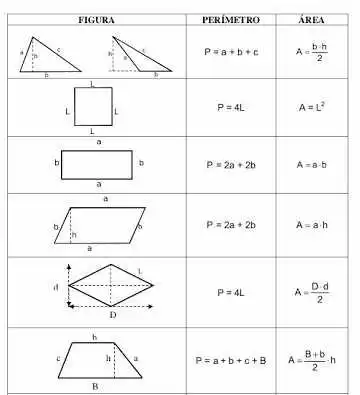
Examples:
Calculate the areas of figures below:
Starting from this point we can see that the reality of the student is full of flat geometric figures, then that student will encounter problems of various complexities, so the geometric knowledge becomes important to the intellectual training the student because it will provide you with skills and abilities that will help you get situated and solve certain problems in the environment into which it is inserted.
According to the national curriculum Parameters – PCN's (BRAZIL, 1998), the geometric concepts are an important part of the curriculum of Mathematics in middle school, because through this the student develops a special kind of thinking that allows you to understand and represent the world in which he lives. If this worked from the physical world, allows students to make connections between mathematics and other areas of knowledge.
It is understandable that according to NCPs's learning geometry is of paramount importance in all levels of education. However the teachers for several reasons do not care about the teaching of geometry and so little in search features that facilitate the teaching-learning and to make that learning more dynamic, without deviating from the context. Observing that some authors to develop their textbooks put that content in the last chapters, making compliance with stroke by educators.
GEOBOARD
The name comes from the joint Geo, Geoboard meaning geometry and plan, which means flat surface therefore Geoboard. Word is that it was first used in 1961, by professor Caleb Gattegno, of the Institute of education, University of London (KNIJNIK, BASSO; KLÜSENER, 1996; Menezes, 2008).
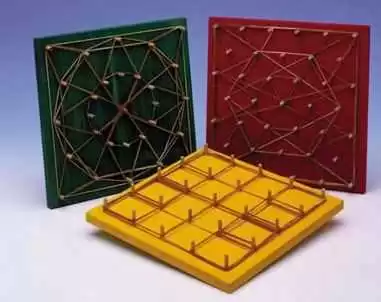
The Geoboard is a piece of flat surface wood with nails tapped the same distance from one another. There are some types of Geoboard: square, Circular, the Trelissado, and the Oval Office. The square is the most widely used, wooden surface compound split so checkered square by equidistant nails. It's a simple confection, which helps students to overcome their difficulties and at the same time learn to manipulate it, it can also be used as a mathematical game that facilitates understanding of the student in playful relationship. This feature allows students to acquire new experiences and also makes it possible your physical form, leaving so abstract, imaginary mode through construction of figures and have an additional gimmick based on pin count from left to right, rows and columns, inside and outside of the enabling work more dynamic, because unlike other games the Geoboard has flexibility, so the students can do and undo at any time with your teacher.
According to Sharma (2009, p. 8) points out that:
In the game you can take risks, try, try, invent, all free of the ghost of a punitive evaluation and neuter. The teacher who uses the game has the role to organize and systematize these activities to enable students to walk in search of new knowledge (…).
However realizes that with the introduction of the Geoboard, can promote the teaching of plane geometry a different way of approaching and represent various fitness content, such as: calculating area and perimeter of polygons.
Field research
After the identification of the Geoboard as a usable resource and able to promote meaningful learning, three questionnaires, two were for the collection of data and another for collection of results.
According to the questionnaire the current teacher replied that never used any didactic resource manipulated and is unaware of the Geoboard. The previous series in your report states that made use of other manipulable materials, including the Geoboard. These brought controversial because according to the interview with students, they claimed not to know the material.
The contents worked, were calculations of areas and perimeters of figures flat, before we apply the workshop we also an interview with the class, we detected a great difficulty for them to recognize the Geoboard, few polygons, calculate areas and perimeters, as shown in the following results.
1st) YOU KNOW the GEOBOARD?
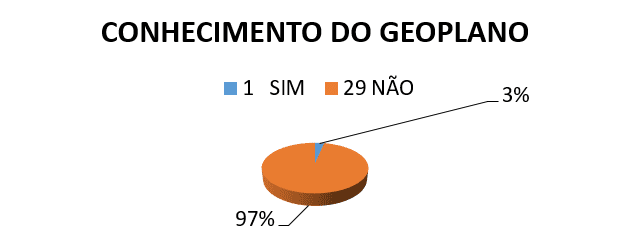
2nd) GEOMETRY CLASSES the PROFESSOR HAS ALREADY USED SOME SORT of USABLE MATERIAL?
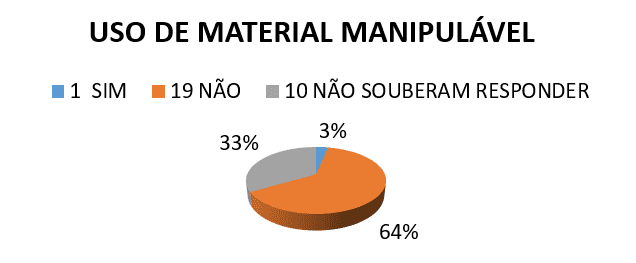
3rd) you know what is PERIMETER or area?
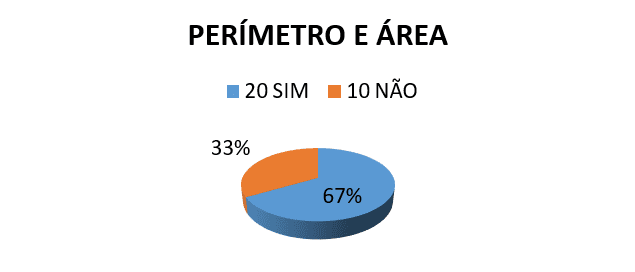
4) which FIGURES BELOW DO YOU KNOW?
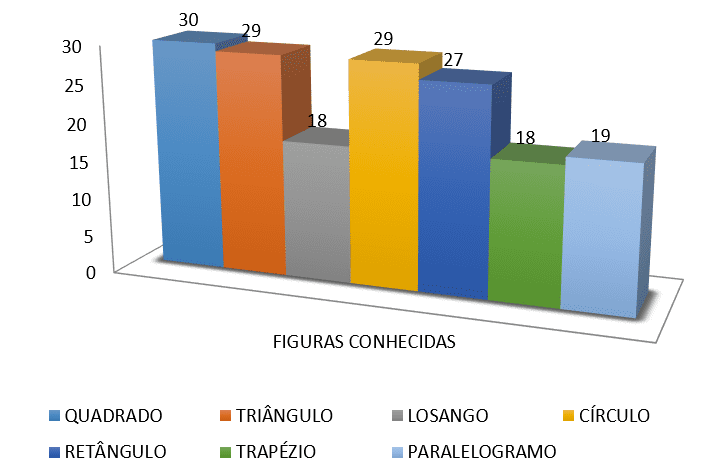
5) you know CALCULATE the perimeter or the area of SOME of THESE FIGURES?
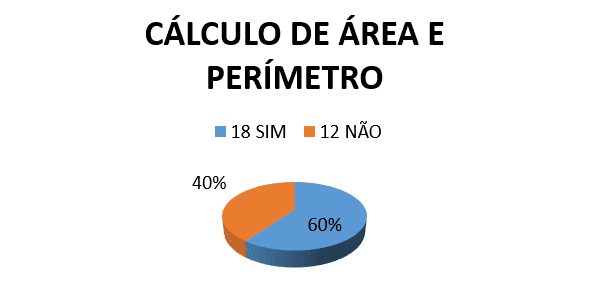
By analyzing the data obtained, it was realized the need to conduct a workshop, in which the Geoboard was presented as a resource for teaching and learning. Through this workshop we seek show so versatile as handling this feature.
Divided in five groups of six students, each group was given two Geoplanos, a square, a circle and a certain amount of elastic. In a first moment after being delivered the Geoplanos students, they've had for a while the freedom to handle and build figures according to the imagination of each.
With the use of slides, there was an approach showing the main regular polygons. Soon after, challenged the students to perform calculations of perimeters and areas of various polygons using the Geoboard and checkered mesh. This challenge brought a participatory movement on the part of students, in the case of something different from your everyday life. The Geoboard when used charms, arouses interest and bring versatility to class.
Smole, Diniz and Cândido highlight that:
One of the great advantages of the geoboard is, unlike the sheet of paper, he has mobility, is "dynamic", and the flexibility with which they can do and undo construction allows the child get used to see figures in several positions, notice if a given a chance I did for the solution of a problem is suitable and correct it right away if necessary. (2003, p. 112).
During the workshop through comments, it was noted that there was an improvement in student performance when performing the calculations proposed, also an effective participation in the class.
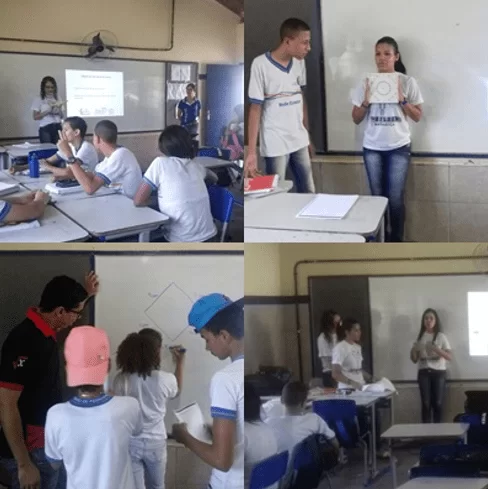
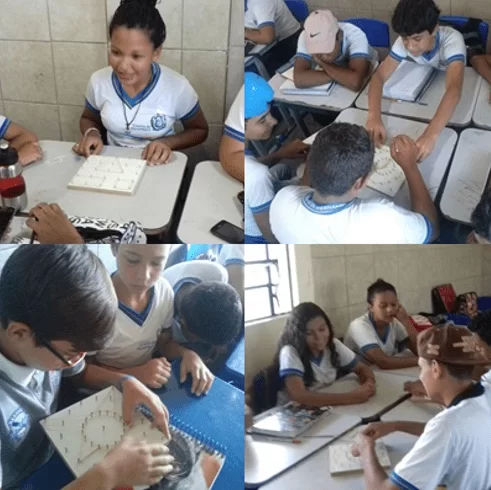
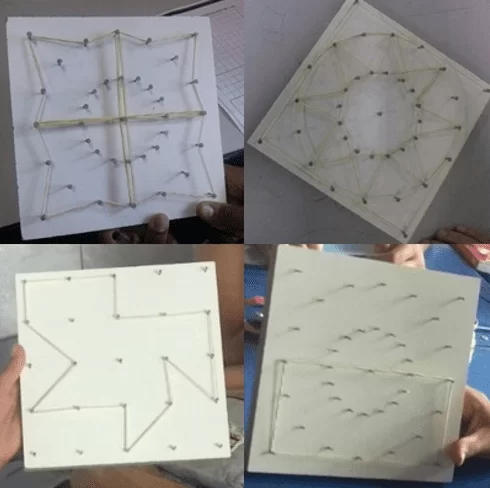
As learning evaluation there was the need to perform another questionnaire with the students for the confirmation of the results obtained as shown in the graphics.
1st) the GEOBOARD COULD BE USED in geometry?
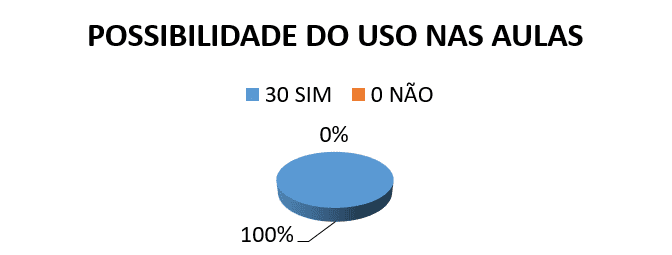
2nd) THIS FEATURE FACILITATED calculating area and perimeter?
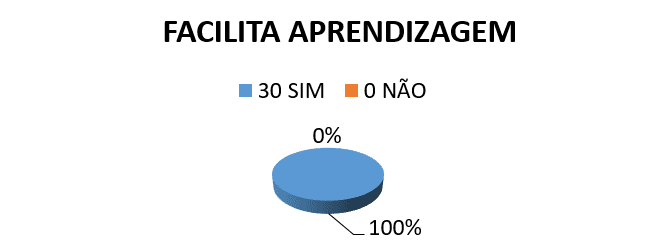
3rd) RATE THEIR PERFORMANCE in HANDLING the GEOBOARD?
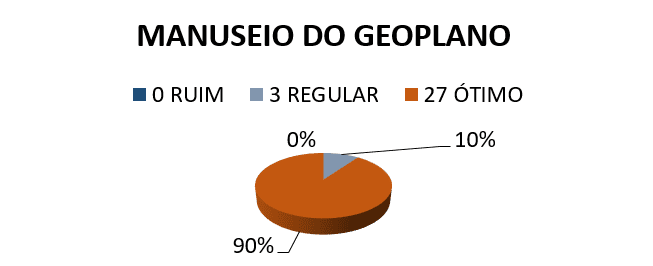
According to the results obtained through the survey conducted with the students after the workshop, it was noticed that there was an effective agreement on the part of students for some results. The first and the second chart shows that 100% of the students agree with the use of the Geoboard in geometry, since this feature facilitated calculating area and perimeter. Still analyzing the results it is possible to notice that this feature is easy to handle, because the third graph presents a high rating in relation to the performance of the students when handling the Geoboard, 10% of the students found your regular handling and performance 90% great.
Therefore the student learning was significant during the execution of the workshop, the same showed enthusiasm, engagement, curiosity and dedication, resolve the challenges proposed using the Geoboard and checkered mesh.
Final considerations
The resources, when well designed, provide to the students the construction of mathematical knowledge, so this job we decided to choose the Geoboard, because it will be from a prior knowledge of this tool for the educator who can offer for educating a different way to expand your cognitive development, providing systematized and concrete situations.
Therefore, this feature will be used as a teaching method in which students can experience different learning situations working symbols, solve problems involving perimeter and area of polygons, in which they will be able to do a real analysis What is being experienced. Thereby, the Geoboard, chosen for such fits perfectly in these activities, because according to the national curriculum Parameters, the games in a manner generally are bearers of a relevant aspect, that is a challenge that leads to the student, i.e., it is a great way to encourage him to face new situations where they can put into practice their learnings, losing your fear of learning math.
According to Rego & Rego (2013).
… Through experiments with concrete material, the student develops a taste for the pleasure of discovery, to face challenges and overcome them, developing habits and customs which can lead later to be an individual, and able to act.
It can be concluded that through games, teaching resources and tools facilitators of teaching/learning is possible that educators make math lessons more versatile, attractive to the students.
References
Brazil. Ministry of education. Common Curriculum: Mathematics: MEC, 2015, p. 116.
Brazil. Department of Fundamental Education. National Curriculum: Math Parameter. Brasilia: MEC/SEF .1998.
GH, Claudia Maria. Geometry: space and form. Unochapecó: Chapecó; Coordination of distance education, 2008.
MARKHAM, j. e. (ed.). Knowledge, interdisciplinary and teaching activities with math games: a methodological proposal. Recife: UFRPE, 2008. (Mathematical Context Series)
REGO, R. G; REGO. R. M. Matematicativa. 4. Ed. View. London 2013 (teacher training) p. 25
SANTOS JUNIOR, V. B. D. The mobilization of Mathematical Contents in practical activities in the context of game with Licenciandos of Mathematics. Dissertation (master in science education and mathematics)-graduate program in science and math education, Department of education, Federal Rural University of Pernambuco. Recife, 2011. P. 22-36
SHARMA, Monica Menezes. The playful activity in mathematics classroom: action and reflection. Available in <http: sbem.com.br/files/ix/enem/minicurso/trabalhos="">.</http:> Accessed on October 20 2009.
SMOLE, Kátia Cristina Stocco; DINIZ, Maria Ignez de Souza Vieira; Candide, Patricia Terezinha. Figures and shapes. Porto Alegre: New Haven, 2003. (0 to 6 mathematical Collection, v. 3).
[1] Graduating in the course of degree in Mathematics of the CESA.
[2] Graduating in the course of degree in Mathematics of the CESA.
[3] Graduating in the course of degree in Mathematics of the CESA.
[4] Graduating in the course of degree in Mathematics of the CESA.
[5] Graduating in the course of degree in Mathematics of the CESA.
[6] Advisor. Professor of CESA.
[7] The PIBID is a program of the Federal Government that wants to encourage the training of teachers in higher level for basic education, contributing to the enhancement of the teaching profession. More information access:<HTTP: www.capes.gov.br/educacao-basica/capespibid=""></HTTP:>



